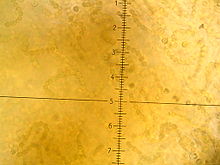This article includes a list of general references, but it lacks sufficient corresponding inline citations. (September 2023) |
| Fat choy | |
|---|---|

| |
| Nostoc flagelliforme under a microscope | |
| Scientific classification | |
| Domain: | Bacteria |
| Phylum: | Cyanobacteria |
| Class: | Cyanophyceae |
| Order: | Nostocales |
| Family: | Nostocaceae |
| Genus: | Nostoc |
| Species: | N. flagelliforme
|
| Binomial name | |
| Nostoc flagelliforme | |
| Synonyms[1] | |
| Fat choy | |||||||||||||||
|---|---|---|---|---|---|---|---|---|---|---|---|---|---|---|---|
 | |||||||||||||||
| Traditional Chinese | 髮菜 | ||||||||||||||
| Simplified Chinese | 发菜 | ||||||||||||||
| Literal meaning | "hair vegetable" | ||||||||||||||
| |||||||||||||||
| Alternative Chinese name | |||||||||||||||
| Traditional Chinese | 頭毛菜 | ||||||||||||||
| |||||||||||||||
Fat choy (traditional Chinese: 髮菜; simplified Chinese: 发菜; pinyin: fàcài; Jyutping: faat³ coi³; Nostoc flagelliforme) is a terrestrial cyanobacterium (a type of photosynthetic bacteria) that is used as a vegetable in Chinese cuisine. When dried, the product has the appearance of black hair. For that reason, its name in Chinese means "hair vegetable". When soaked, fat choy has a soft texture which is like very fine vermicelli.
Production
[edit]Fat choy grows on the ground in the Gobi Desert and the Qinghai Plateau. Over-harvesting on the Mongolian steppes has furthered erosion and desertification in those areas. The Chinese government has limited its harvesting, which has caused its price to increase.[2][needs update?]
Commercially available fat choy has been found to be adulterated with strands of a non-cellular starchy material, with other additives and dyes.[2][3] Real fat choy is dark green in color, while the counterfeit fat choy appears black.[2]
Use
[edit]China
[edit]Its name in Cantonese sounds like a Cantonese phrase meaning "struck it rich" (though the second syllable, coi, has a different tone) -- this is found, for example, in the Cantonese saying, "Gung1 hei2 faat3 coi4" (恭喜發財, meaning "wishing you prosperity"), often proclaimed during Chinese New Year. Therefore, it is a popular ingredient for Chinese New Year dishes, such as in the reunion dinner. It is mostly used in Cantonese cuisine and Buddhist cuisine. It is sometimes used as a hot pot ingredient.
Due to its high price, fat choy is considered a luxury food, and only used in limited occasions. It is not eaten as a staple.[4]
Health effects
[edit]N. flagelliforme has no nutritional value,[dubious – discuss] and also contains beta-N-methylamino-L-alanine (BMAA), a toxic amino acid that could affect the normal functions of nerve cells and is linked to degenerative diseases such as ALS, Alzheimer's, Parkinson's, and dementia.[5] Not all real fat choy samples contain BMAA according to a 2009 study, with the maximum concentration being 658.5 ng/g. Imitation fat choy does not contain BMAA.[4]
Across a 28-day duration, laboratory rats fed N. flagelliforme and the control group did not exhibit significant differences in any toxicological parameters.[6]
The algae and its extracts reduce the inflammatory action of white blood cells, specifically macrophages and splenocytes, in vitro.[7]
References
[edit]- ^ a b Calvo-Pérez, Juan Diego; Molinari-Novoa, Eduardo A.; Guiry, Michael D. (23 March 2016). "Validation of Nostoc flagelliforme (Nostocaceae, Cyanobacteria)" (PDF). Notulae Algarum (2): 1–2. ISSN 2009-8987. Retrieved 15 January 2019.
- ^ a b c "The standard.com.hk". Archived from the original on November 22, 2007. Retrieved 22 October 2018.
- ^ "Waynesword". Archived from the original on 2004-10-10. Retrieved 2004-11-07.
- ^ a b Roney, BR; Renhui, L; Banack, SA; Murch, S; Honegger, R; Cox, PA (2009). "Consumption of fa cai Nostoc soup: a potential for BMAA exposure from Nostoc cyanobacteria in China?". Amyotrophic Lateral Sclerosis. 10 (Suppl 2): 44–9. doi:10.3109/17482960903273031. PMID 19929731. S2CID 2893117.
- ^ The standard.com.hk. Mimi Lau, January 30, 2007, Ban sought on Lunar delicacy Archived November 22, 2007, at the Wayback Machine
- ^ Takenaka 1998.
- ^ Ku, Lee (2013). "Edible blue-green algae reduce the production of pro-inflammatory cytokines by inhibiting NF-κB pathway in macrophages and splenocytes". Biochimica et Biophysica Acta (BBA) - General Subjects. 1830 (4): 2981–2988. doi:10.1016/j.bbagen.2013.01.018. PMC 3594481. PMID 23357040.
- But, Paul Pui-Hay; Cheng, Ling; Chan, Pui Kwan; Lau, David Tai-Wai; But, Joyce Wing-Hin (2002). "Nostoc flagelliforme and faked items retailed in Hong Kong". Journal of Applied Phycology. 14 (2): 143–145. Bibcode:2002JAPco..14..143B. doi:10.1023/a:1019518329032. ISSN 0921-8971. S2CID 6195505.
- Takenaka, H.; Yamaguchi, Y.; Sakaki, S.; Watarai, K.; Tanaka, N.; Hori, M.; Seki, H.; Tsuchida, M.; Yamada, A.; Nishimori, T.; Morinaga, T. (1 December 1998). "Safety evaluation of Nostoc flagelliforme (nostocales, Cyanophyceae) as a potential food". Food and Chemical Toxicology (United Kingdom). 36 (12): 1073–1077. doi:10.1016/S0278-6915(98)00089-1. ISSN 0278-6915. PMID 9862649. Archived from the original on 22 October 2018. Retrieved 22 October 2018.
External links
[edit]- "Cyanobacteria Photos". waynesword.palomar.edu. Archived from the original on 10 October 2004. Retrieved 22 October 2018.
- "food for thought". sg.bcmagazine.net. 1 February 2004. Archived from the original on 1 February 2004. Retrieved 22 October 2018.